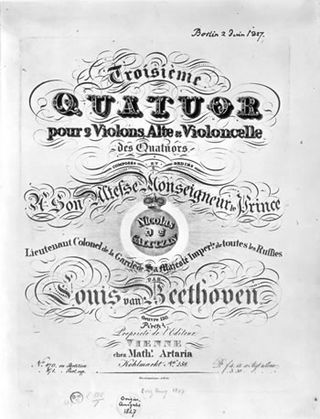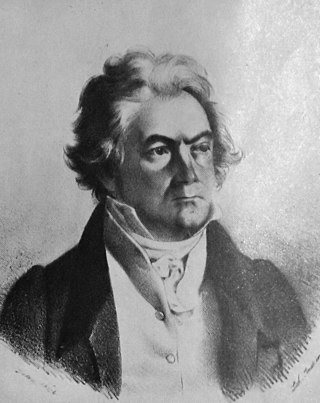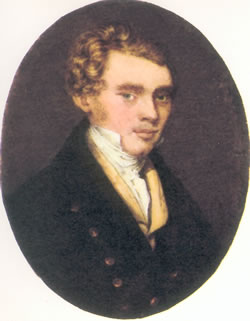Related Research Articles

Ludwig van Beethoven was a German composer and pianist. He is one of the most revered figures in the history of Western music; his works rank among the most performed of the classical music repertoire and span the transition from the Classical period to the Romantic era in classical music. His early period, during which he forged his craft, is typically considered to have lasted until 1802. From 1802 to around 1812, his middle period showed an individual development from the styles of Joseph Haydn and Wolfgang Amadeus Mozart, and is sometimes characterized as heroic. During this time, Beethoven began to grow increasingly deaf. In his late period, from 1812 to 1827, he extended his innovations in musical form and expression.

The term string quartet refers to either a type of musical composition or a group of four people who play them. Many composers from the mid-18th century onwards wrote string quartets. The associated musical ensemble consists of two violinists, a violist, and a cellist. The double bass is almost never used in the ensemble mainly because it would sound too loud and heavy.
In music, the opus number is the "work number" that is assigned to a musical composition, or to a set of compositions, to indicate the chronological order of the composer's publication of that work. Opus numbers are used to distinguish among compositions with similar titles; the word is abbreviated as "Op." for a single work, or "Opp." when referring to more than one work. Opus numbers do not necessarily indicate chronological order of composition. For example, posthumous publications of a composer's juvenilia are often numbered after other works, even though they may be some of the composer's first completed works.
This is a list of music-related events in 1812.

The String Quartet No. 1 in F major, Op. 18, No. 1, was written by Ludwig van Beethoven between 1798 and 1800, published in 1801. The complete set of six quartets was commissioned by and dedicated to the Bohemian aristocrat Joseph Franz von Lobkowitz. It is actually the second string quartet that Beethoven composed, following his third.

Ludwig van Beethoven composed his String Quartet No. 4 in C minor, Op. 18, No. 4, between 1798 and 1800 in Vienna and published in 1801. The Op. 18 collection is dedicated to Joseph Franz von Lobkowitz.

The String Quartet No. 6 in B-flat major, Op. 18, No. 6, was written between 1798 and 1800 by Ludwig van Beethoven and published in 1801, and dedicated to Joseph Franz von Lobkowitz.

The String Quartet No. 14 in C♯ minor, Op. 131, was completed by Ludwig van Beethoven in 1826. It is the last-composed of a trio of string quartets, written in the order Opp. 132, 130, 131.

The String Quartet No. 13 in B♭ major, Op. 130, by Ludwig van Beethoven was completed in November 1826. The number traditionally assigned to it is based on the order of its publication; it is actually Beethoven's 14th quartet in order of composition. It was premiered in March 1826 by the Schuppanzigh Quartet and dedicated to Nikolai Galitzin on its publication in 1827.
The three Razumovskystring quartets, opus 59, are a set of string quartets by Ludwig van Beethoven. He wrote them in 1806, as a result of a commission by the Russian ambassador in Vienna, Count Andreas Razumovsky:

Ludwig van Beethoven's late string quartets are:
E major is a major scale based on E, consisting of the pitches E, F♯, G♯, A, B, C♯, and D♯. Its key signature has four sharps. Its relative minor is C-sharp minor and its parallel minor is E minor. Its enharmonic equivalent, F-flat major, has six flats and the double-flat B, which makes that key less convenient to use.

The String Quartet No. 15 in A minor, Op. 132, by Ludwig van Beethoven, was written in 1825, given its public premiere on November 6 of that year by the Schuppanzigh Quartet and was dedicated to Count Nikolai Galitzin, as were Opp. 127 and 130. The number traditionally assigned to it is based on the order of its publication; it is actually the thirteenth quartet in order of composition.

The String Quartet No. 8 in E minor, Op. 59, No. 2, was written by Ludwig van Beethoven and published in 1808. This work is the second of three of his "Rasumovsky" cycle of string quartets, and is a product of his "middle" period.

The Grosse Fuge, Op. 133, is a single-movement composition for string quartet by Ludwig van Beethoven. An immense double fugue, it was universally condemned by contemporary music critics. A reviewer writing for the Allgemeine musikalische Zeitung in 1826 described the fugue as "incomprehensible, like Chinese" and "a confusion of Babel". However, critical opinion of the work has risen steadily since the early 20th century and it is now considered among Beethoven's greatest achievements. Igor Stravinsky described it as "an absolutely contemporary piece of music that will be contemporary forever".

The Pražák Quartet is a Czech string quartet established in 1974. It is one of the Czech Republic's premiere chamber ensembles. It was founded while its members were still students at Prague Conservatory (1974–1978). The quartet was awarded First Prize at the Evian International Competition in 1978 and the Prague Spring Festival Prize in 1979 with second places not being awarded at both the competitions to indicate the difference in level.

Karl Holz was an Austrian violinist. He played second violin in Ignaz Schuppanzigh's string quartet and served as secretary to Ludwig van Beethoven during the last few years of the composer's life. He was also close with Franz Schubert.
Bernard Zaslav was an American viola soloist and chamber musician with an extensive recording and performance career. A founding member of The Composers Quartet in 1965, he went on to play with the Fine Arts Quartet, Vermeer Quartet, and the Stanford String Quartet. He has also performed and recorded as the Zaslav Duo with his wife, pianist Naomi Zaslav.
References
Citations
- 1 2 Kerman, Joseph (1967). The Beethoven Quartets. New York: Knopf.
- ↑ "Beethoven's String Quartets". All about Beethoven. Retrieved 31 March 2010.
- ↑ Beethoven's Letters , p. 28, at Google Books. (1926 edition, Dent/Shedlock/Kalischer editing/translating.) "again" means, as Kerman corroborates in his discussion of the quartets, that this is a reference to the 2nd book - nos. 4-6 - not necessarily all six quartets, despite the editors' footnote in this edition of his letters.
- ↑ However, the early version of no. 1 - an autograph copy sent to, and kept by, Karl Amenda before Beethoven gave the quartet a thorough overhaul - is little-known and has been recorded, as of July 2014, less than six times.
- ↑ Kinderman, William (2010). The String Quartets of Beethoven. University of Illinois Press. p. 13. ISBN 0252091620.
- ↑ Kerman, Joseph (1979). The Beethoven Quartets. W. W. Norton & Company. p. 30. ISBN 0393009092.
- ↑ Zbikowski 2002, 177–198, quoting A. B. Marx's Ludwig van Beethoven: Leben und Schaffen, 6th ed., ed. Gustav Behncke, (Berlin: Otto Janke, 1908): 203.
Bibliography
- Zbikowski, Lawrence M. 2002. Conceptualizing Music: Cognitive Structure, Theory, and Analysis. American Musicological Society Studies in Music Series, gen. ed. Lawrence F. Bernstein. Oxford: Oxford University Press. ISBN 978-0-19-514023-1 (hbk).
- Vernon, David. Beethoven: The String Quartets. Edinburgh: Candle Row Press, 2023. ISBN 978-1739659929.